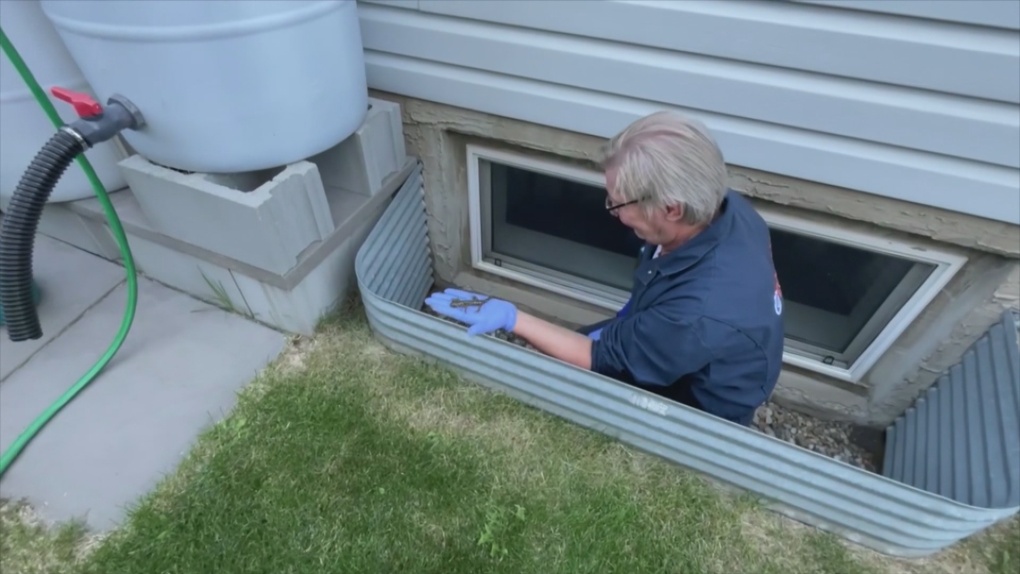Due to the secretive subterranean lives of tiger salamanders, many Edmontonians can count themselves lucky to ever see one.
That said – lucky wasn’t the word leaping to mind for one local woman when thousands of the normally-elusive amphibians recently descended on her childhood home.
“It was like something you would read in the end times,” Chelsea Brown said. “It was the craziest thing I’ve ever seen.”
Western tiger salamanders, named for their spots and stripes, are found in most of central and southern Alberta.
Salamanders breed in the spring and lay their eggs in local bodies of water.
Once hatched, the legless larvae – similar to a tadpole – feed on invertebrates like mosquito and other insect larvae, and in August they emerge transformed into four-legged terrestrial replicas of their parents.
“They will span out into their surroundings and start to fill their bellies with all types of prey items, basically anything that they can get into their mouths and swallow, they will eat,” said Kris Kendall, a biologist with the Alberta Conservation Association (ACA).
A small wester tiger salamander can be seen after being rescued from a window well in the Edmonton area in September, 2024. (CTV News Edmonton)Despite tiger salamanders being one of the province’s most common amphibians – and one the largest salamander species in North America – they’re rare to see.
“They are very secretive. They spend a lot of their lives underground,” Kendall said.
“They’re often active after dark, and consequently people don’t often notice them.”
‘A once-in-a-lifetime thing’
It was impossible for Brown not to notice them after a large herd suddenly appeared while she was decorating her parent’s house for her daughter’s birthday party in mid-August.
“There were salamanders from the front door going all the way to the driveway,” Brown said.
“In the lawn, in our rock garden, the neighbour’s driveway, across the street, crossing the street, hanging out at the corner … all along the sidewalk going down to the lake here behind me.
“It was absolutely crazy.”
Not wanting them to get run over or snacked on by local pets, Brown leapt into action with an old ice cream bucket, scooping up dozens of salamanders and carrying them to the nearby lake.
It was an exercise in futility, she said.
“We come back and as we’re walking up it’s almost like we didn’t even move them,” Brown said. “They were exactly where we had picked them up from, and the same amount.”
“They had made a little party area in the play pool … they were just hanging out, you know, doing the backstroke and whatever.”
 Dozens of salamanders can be seen in an ice cream pail after being scooped up by Chelsea Brown during a large-scale invasion of the amphibians in August. (Chelsea Brown/CTV News Edmonton)The invasion lasted around two days in full force, with numbers dwindling to almost nothing by the end of the week.
Dozens of salamanders can be seen in an ice cream pail after being scooped up by Chelsea Brown during a large-scale invasion of the amphibians in August. (Chelsea Brown/CTV News Edmonton)The invasion lasted around two days in full force, with numbers dwindling to almost nothing by the end of the week.
Brown was afraid at first, not knowing if the salamanders posed a health risk, but after talking to several experts (who she hoped could help rehome the slimy sightseers), she said she came to view the ordeal with newfound appreciation.
“Everybody I talked to, they’re like, ‘That’s the coolest thing I’ve ever heard,'” she said. “It is cool.
“It was a once-in-a-lifetime thing. Even people that deal with them for a living don’t get to experience something like that.”
How to handle unwanted guests
Local tiger salamanders are currently finishing fattening up and migrating to burrowing sites where they will hibernate below the frost line for winter.
It’s this time of year when the salamanders are most likely to become trapped in window wells, sump pumps and buckets, according to the Edmonton and Area Land Trust (EALT).
“We actually do get quite a few people who freak out,” said Neil Ritokoski, a field supervisor for EcoPest Control. “They don’t understand them, so they think it’s something dangerous.”
Tiger salamanders secrete a foul-tasting toxin from their skin. However, Kendall said they won’t harm pets or people if eaten or touched (though you should always wash your hands after any wildlife encounter, he added).
Salamanders may give some people the “ick,” Ritokoski said, but he personally considers it a compliment if one chooses to visit.
Like other amphibians, they are sensitive to changes in the environment and can’t survive in an unhealthy ecosystem.
“You have a salamander? Congratulations,” Ritokoski said. “That’s a sign that your yard is a good yard.”
 Neil Ritokoski with Eco Pest rescues a tiger salamander trapped in a window well at an Edmonton-area home in September, 2024. (CTV News Edmonton)Most salamanders will leave on their own. If one does get trapped in your yard, you can gently scoop it into a bucket of water and release it near a lake or pond.
Neil Ritokoski with Eco Pest rescues a tiger salamander trapped in a window well at an Edmonton-area home in September, 2024. (CTV News Edmonton)Most salamanders will leave on their own. If one does get trapped in your yard, you can gently scoop it into a bucket of water and release it near a lake or pond.
It’s important to use clean, wet hands, Kendall said, because any chemicals from lotions or perfumes can damage the salamander’s delicate slime coat.
“Even the salt that might be naturally occurring on your hand, that can irritate an amphibian skin or even cause greater harm,” Kendall explained.
Habitat loss and fragmentation, along with the introduction of fish to formerly-fishless water bodies, have negatively impacted tiger salamander populations in Canada; The prairie and boreal populations are listed as a special concern under the federal Species at Risk Act.
Kendall said the species play an important role in the local ecosystem, and people can help track local populations by reporting sightings to the Alberta Volunteer Amphibian Monitoring Program.
With files from CTV News Edmonton’s Amanda Anderson




